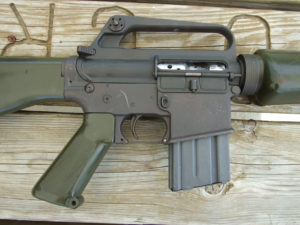

When it comes to AR-15s for survival, there is a strong case to be made for standard direct impingement over newer piston-driven AR designs.
Why a Direct Impingement AR-15?
The gas piston does one main thing to enhance the AR-15 system: it keeps hot powder gases from fouling out the action of the weapon.
In the original direct impingement system, gas is vented from the barrel through a small tube into the receiver, and it is that gas that blows into the bolt carrier to force it back against the buttstock buffer and spring.
When these are compressed, the weapon cycles and forces the carrier back forward, stripping a fresh round from the magazine follower and into the chamber, where the bolt locks up, awaiting the next pull of the trigger.
The action of a direct impingement gun will, of course, eventually be fouled by carbon. With the short-stroke piston action, the gas is vented from the same area from the fore-end, but instead of being directed into the action, is directed against a piston and rod, which in turn cycles the action.
This keeps the action very clean and, in theory, operating more reliably. This is all well and good, but there are several other things a gas piston system does that make it less desirable for the type of survival weapons we’re talking about.
 First, piston-actions cost more than direct impingement ARs.
First, piston-actions cost more than direct impingement ARs.
Second, the design of the piston action generally adds up to an additional pound of weight for the weapon (actually for the weapon carrier). This is weight that could be traded for an equal amount of ounces in water, food, ammunition or medical supplies.
Piston actions also tend to cause a given weapon to be somewhat less accurate than a direct impingement gun, due to a sliding assembly of metal moving across the top of the barrel that interferes with harmonics. Every precision AR out there that I’m aware of, especially those set up for sniper use, runs off direct gas for just that reason.
Just like mid-range direct gas systems, no Mil-Spec standard exists for AR piston guns produced for the civilian market. In fact, there are a bunch of different types and setups out there.
It is not something that can be easily repaired if it fails, since there are no standard parts. Even without the survival factor thrown in, it’s entirely possible that the manufacturer that produced your weapon won’t be around to make good on that “lifetime guarantee” they provided to help you.
This article is an expert from the Gun Digest Book of Survival Guns.

Next Step: Get your FREE Printable Target Pack
Enhance your shooting precision with our 62 MOA Targets, perfect for rifles and handguns. Crafted in collaboration with Storm Tactical for accuracy and versatility.
Subscribe to the Gun Digest email newsletter and get your downloadable target pack sent straight to your inbox. Stay updated with the latest firearms info in the industry.

![Best Concealed Carry Guns In 2025 [Field Tested] Wilson Combat EDC X9S 1](https://gundigest.com/wp-content/uploads/Wilson-Combat-EDC-X9S-1-324x160.jpg)


![Best 9mm Carbine: Affordable PCCs [Tested] Ruger Carbine Shooting](https://gundigest.com/wp-content/uploads/Ruger-Carbine-Shooting-100x70.jpg)
![Best AR-15: Top Options Available Today [Field Tested] Harrington and Richardson PSA XM177E2 feature](https://gundigest.com/wp-content/uploads/Harrington-and-Richardson-PSA-XM177E2-feature-100x70.jpg)

Great article,thanks for the information.